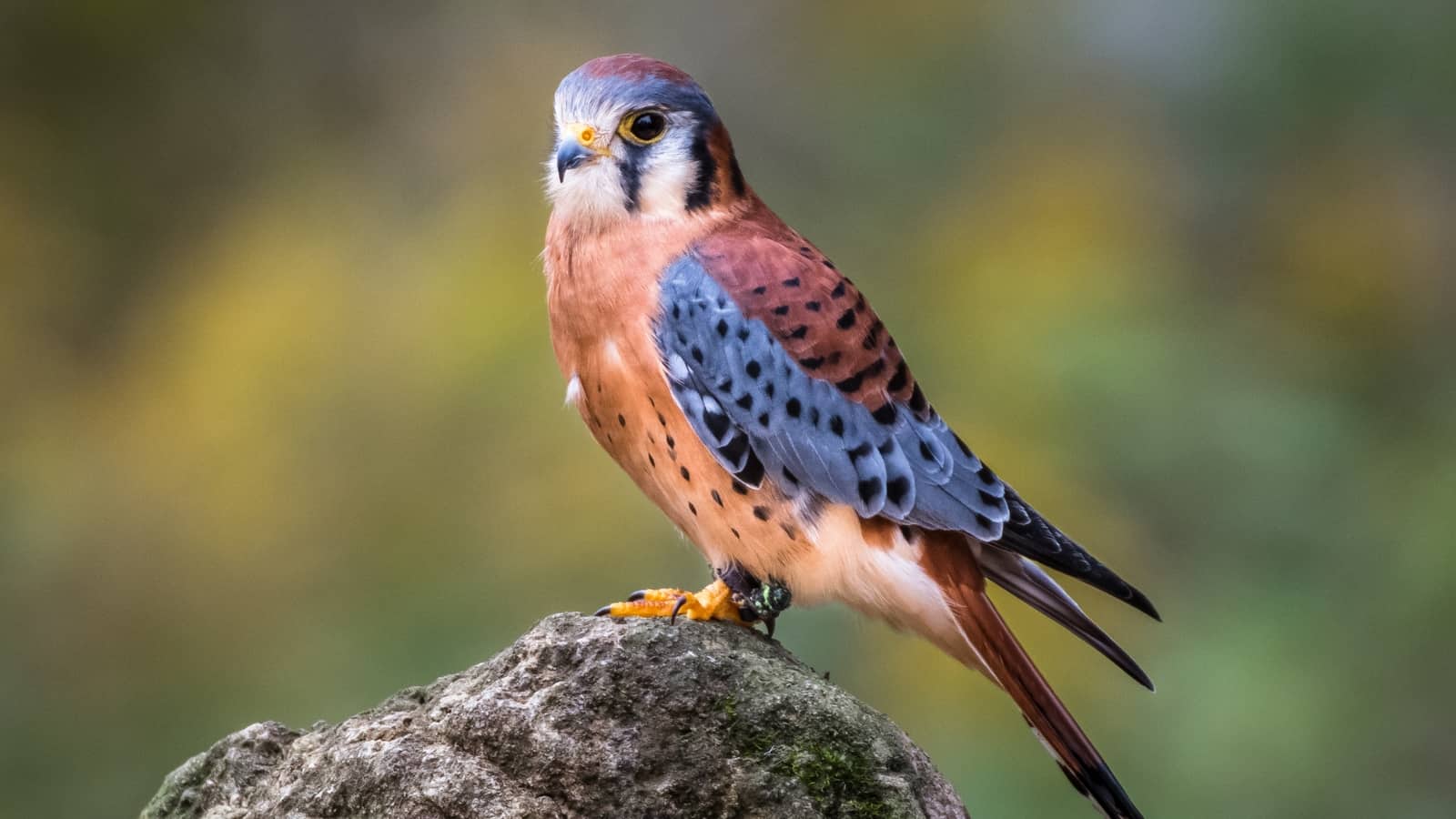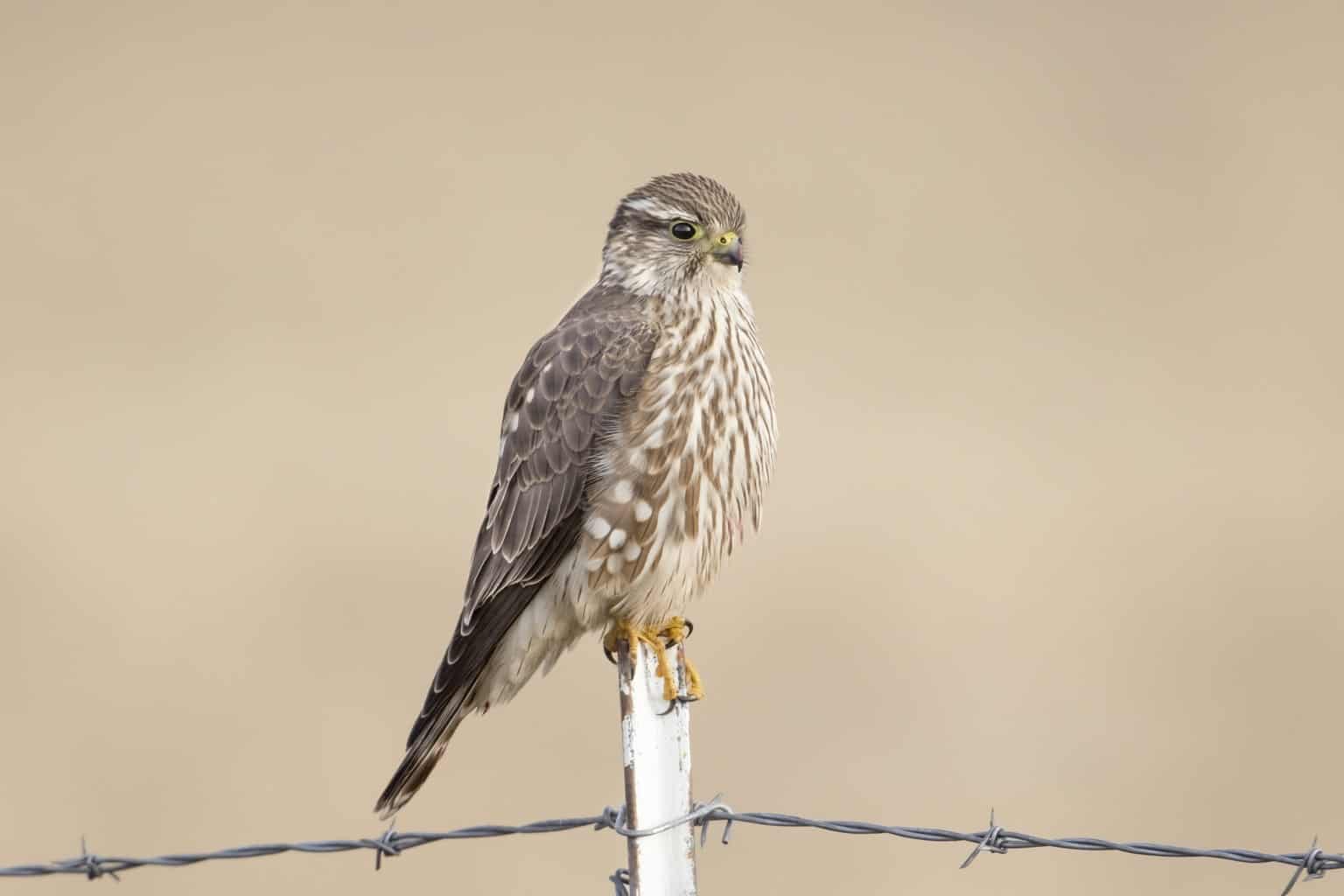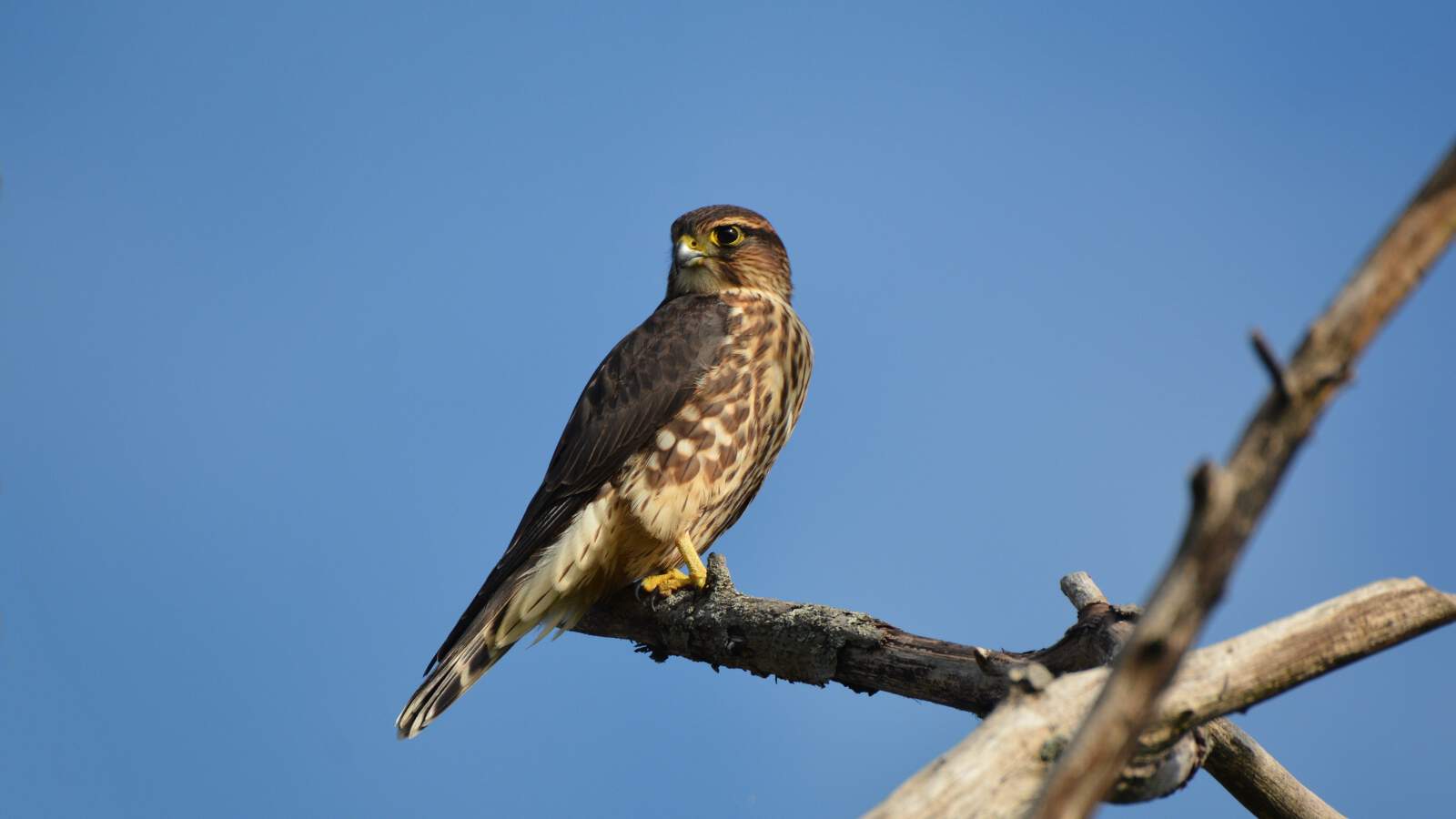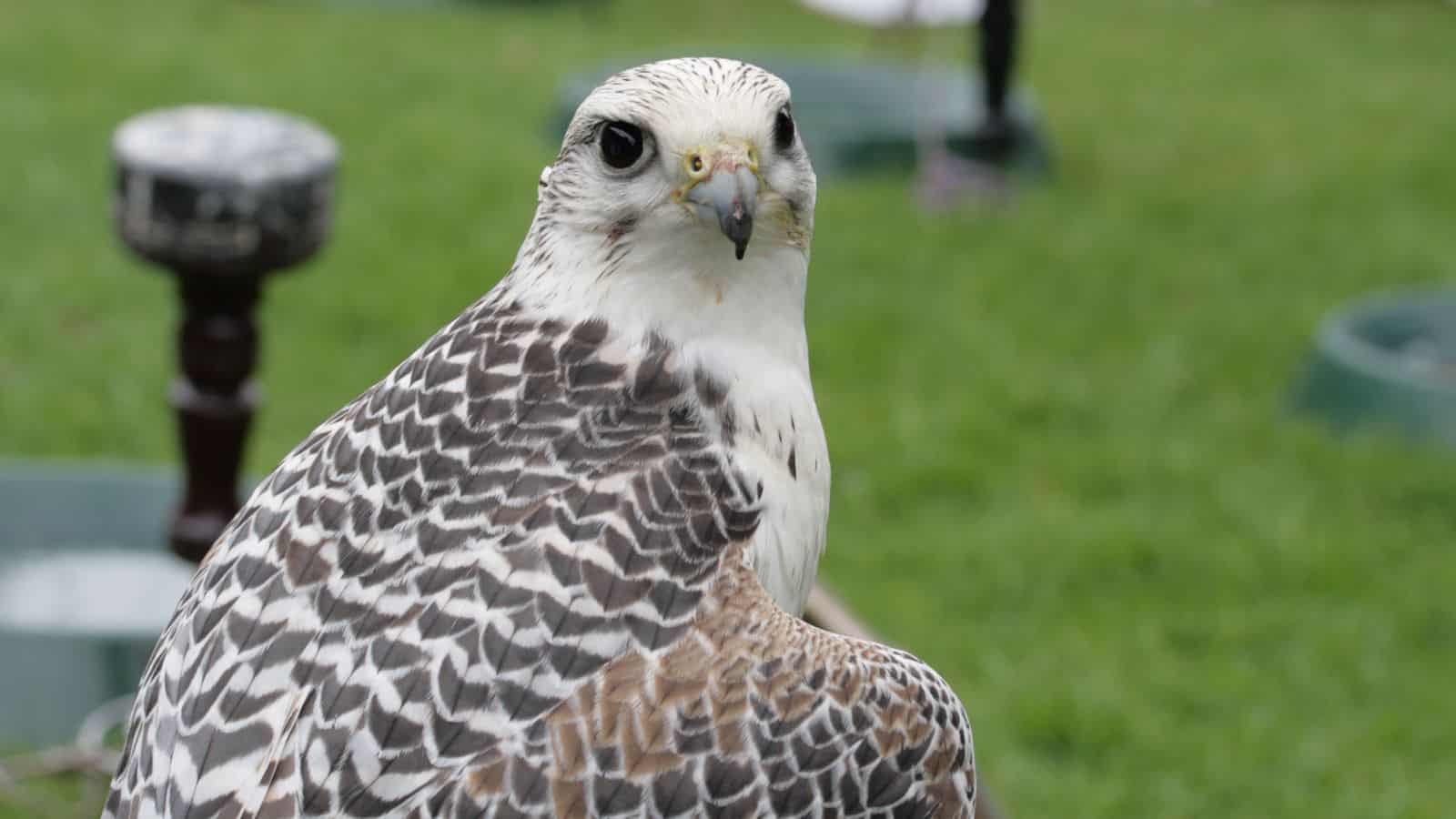How can you resist a little birdwatching in the Sunshine State? You not only get plenty of sun and ocean to enjoy, you also can spot 6 different falcon species.
Growing up in California was magical as a budding birdwatcher, I was able to see plenty of different bird species such as birds of prey, seabirds, waterfowl, hummingbirds, and then some.
I’ll help you spot 6 common and rare falcon species in California so you can experience the same wonder I did. I’ll share ideal locations, seasons, and a few fun facts!
Peregrine Falcon

- Species Name: Falco peregrinus
- Weight: 330 grams to 1,500 grams
- Length: 34 cm to 58 cm
- Wingspan: 29 cm to 47 cm
Let’s start this list of Californian birdwatching with the iconic peregrine falcon! These stocky birds are one of the easier falcons to spot, though you might need to do a little traveling.
Appearance
The peregrine falcon is not an easy bird to overlook. With their dark gray wings, barred chest, and vivid yellow legs, they’re a bold sight against California’s bright skies.
Quick tip: male and female falcons are usually indistinguishable from each other apart from their size. Female peregrine falcons are much bigger and bulkier than males, often with fluffier chests, too.
Range
These fierce birds are year-round residents of California (can you blame them?). They’re most likely to appear along cliff edges or near bodies of water, particularly rivers or along the coast.
However, you may just spot a few near more urban areas. Since they’re so adaptable, they’re not as shy as other falcons are around people.
Diet
The peregrine falcon has a more specialized diet than other members of its species – other birds! They’re commonly found hunting waterfowl, gamefowl, and songbirds.
However, if their local bird supply runs low, they’ll hunt bat species and the occasional small mammal.
Need a starting point? Check out the Tijuana River National Estuarine Nature Reserve to see a healthy population of local peregrine falcons.
Breeding
Peregrine falcons nest in Alaska, Yukon, the Northwest Territories, Quebec, Newfoundland & Labrador. They also breed further south in Montana, Wyoming, Utah, Colorado, Arizona, and New Mexico.
Members of this species are believed to mate for life and prefer to take over nests left behind by large avian species. Alternatively, they may opt to scrape out a shallow depression in which to lay about 3 or 4 pale brown eggs speckled with brown.
The female is mainly responsible for incubating her eggs and does this for about five weeks.
The male fetches food for his mate and his new hatchlings when they arrive. Later, the new mother joins her mate in obtaining food for their new family.
Seven weeks after hatching, their young will try out their new wing feathers.
Birdcall
Peregrine falcons sound like they’re all business. They vary up their calls from sharp eep-eeps to rough kak-kak-kaks.
Fun Fact
The peregrine falcon can hit up to 200 miles per hour, but that’s not all you should know about their agile flight. They’re so fast, they can even catch other fast birds in mid-air.
American Kestrel

- Species Name: Falco Sparverius
- Weight: 80 grams to 165 grams
- Length: 22 cm to 31 cm
- Wingspan: 51 to 61 cm
One of my absolute favorite bird species is the darling American Kestrel. I’ve spoken previously about how much I love their plumage, but it bears repeating!
Appearance
How can you not love the male American Kestrel’s colorful feathers? These bold birds have cinnamon-brown bodies with white chests, blue wings, and reddish-brown legs.
Another notable feature is their patchwork faces – they have white cheeks with black facial markings and a blue head.
Female American Kestrels have similar coloration but are heavier on the brown with less blue. You could say they look softer while the males look more intense.
Range
These falcons are incredibly easy to spot in California, showing up in the state year-round in various locations. Expect to see particularly large numbers during spring and summer.
Try to steer clear of California’s dense forests in favor of wide, open spaces. These falcons prefer a spacious view so they can more easily spot prey or avoid predators.
They’re also big fans of human-made nest boxes, so consider building one in a wide, open space near your home. You’ll be able to see them much more often that way!
Diet
American Kestrels are quite small – weighing as much as a handful of pennies – so their diet often matches their size. These birds generally go after small prey such as grasshoppers, crickets, beetles, spiders, and dragonflies.
Breeding
The American kestrel lays about 4 or 5 eggs, generally white or cream and heavily speckled with brown. The female handles the bulk of incubation duties with occasional help from her mate.
The period itself lasts about a month, following which their chicks hatch. Their young also fledge after a month, then they leave the nest.
Birdcall
These birds may be small, but they boast a classic falcon call. Keep a close ear out for the American Kestrel’s klee-klee-klee pattern.
Fun Fact
American Kestrels have a difficult time making holes in trees, so they’ll sometimes use leftover woodpecker holes to build their nests.
Prairie Falcon

- Species Name: Falco mexicanus
- Weight: 500 grams to 970 grams
- Length: 38 cm to 45 cm
- Wingspan: 102 to 107 cm
Want another falcon that’s easy to spot in California? The prairie falcon is one of the more common species, though you’ll still need to avoid densely forested areas.
Appearance
The prairie falcon is a dusky and subtle bird, boasting a pale brown body with heavy white flecks. Their bright yellow legs and yellow beaks are striking against their subdued feathers.
Males and females look quite similar, though females are characteristically bigger.
Range
Expect to see this bird in California year-round, though you’ll have an easier time spotting them in late fall and early winter. They’re not fans of dense forests or high mountains, so seek out prairies, meadows, and agricultural fields instead.
They’re also quite comfortable in the desert, so consider visiting southern California to increase your chances.
The Big Morongo Canyon Preserve is a fantastic location to spot prairie falcons (as well as a few other falcons on this list).
Diet
The peregrine falcon is a keen hunter of different animal species, eating a variety of small birds, lizards, and snakes. They’ll also hunt readily available small mammals such as chipmunks and squirrels.
Birdcall
The prairie falcon has a sharp and assertive call, letting out shrill kik-kik or kek-kek patterns.
Fun Fact
While other birds will spend a lot of time building nests from scratch, prairie falcons prefer to nest in crevices or holes.
Merlin

- Species Name: Falco columbarius
- Weight: 125 grams to 300 grams
- Length: 24 cm to 33 cm
- Wingspan: 58 cm to 66 cm
While not as common in California as American Kestrels or prairie falcons, you’ll still see these lovely birds year-round. They also have quite a few interesting subspecies that change their plumage colors!
Appearance
No matter their coloration, the merlin is a delicate falcon with a sleek body and very large, dark eyes. They have tiny yellow beaks and tend to have boldly colored chests.
- Black Merlin – a deep gray-blue with a bright white stomach coated in streaks
- Prairie Merlin – a gentle brown with a bright stomach spotted with heavy flecks
- Pacific Northwest Merlin – a pretty dark blue (almost black) with a white stomach
Expect to see the Pacific Northwest Merlin most often in California, but keep an eye out for the other varieties. Honestly, once you learn to spot their unique shape and small size, they’re not as hard to find.
Range
Merlins show up year-round in the state but are a little less densely populated compared to other falcon species. Fortunately, they’re comfortable in a variety of environments such as shrubby areas, open fields, and coasts.
Diet
Merlins usually hunt small bird species, swooping low to the ground to spot their prey or flush them out. However, they sometimes switch to lizards or large insects.
An especially interesting sight is catching breeding pairs hunting simultaneously. They’ll trade places between flushing out prey and striking.
Breeding
Nesting season occurs in late spring or early summer, and prospective parents will select a suitable nest previously abandoned by a hawk or corvid.
Alternatively, they may hollow out a shallow depression to raise their new family. The female lays about four eggs on average – they’re typical of those laid by falcons in that they are pale brown and heavily speckled with dark brown. While she incubates them, her mate occupies himself by procuring food for his family.
The eggs hatch after a month. After another month, during which the newly hatched chicks are tended to by their parents, they fledge. However, they do not fly the nest at once but remain with their parents for another month to enjoy their care.
Birdcall
Merlins have a sharp and cackling call, alternating between a haw-haw-haw pattern or an eee-eee.
Fun Fact
Merlins are so well-known for hunting pigeons they earned the name ‘pigeon hawk’ back in the day.
Crested Caracara

- Species Name: Caracara cheriway
- Weight: 952 grams to 1,348 grams
- Length: 50 cm to 65 cm
- Wingspan: 120 cm to 132 cm
I always get excited to talk about these trippy falcons due to their unusual hunting behaviors and unique appearance. How can you not love a bird that seems to be several different species at once?
Appearance
The crested caracara is a stocky and imposing bird, boasting a chocolate brown body, white throat, and bright orange face. Their beaks look like they’re dipped in silvery-blue paint.
They have long legs that make them look more comfortable on the ground than in the air. Indeed, they don’t always fly to snag their prey.
As is typical for falcons, males and females look extremely similar. However, the size disparity between these two is more subtle.
Range
This species is fairly rare in California but is occasionally spotted here and there in their ideal habitat. Since they sometimes hunt by running and pouncing, they don’t like dense forests or mountainous areas.
Stick to coastal areas – particularly flat, open spaces or areas with a lot of roads – to increase your chances of spotting one. These birds are a great checklist goal if you’re going on a road trip in western California.
Diet
The crested caracara won’t lose its comparisons to vultures any time soon, because they have a fondness for carrion or stealing other animal’s kills. However, they’ll still hunt small animals, fish, and lizards when they get the opportunity.
Breeding
Crested caracaras’ choice of breeding season varies depending on their location. In Arizona, these raptors lay their eggs between April and June. However, in Texas, they tend to lay them between January and March. In Florida, members of the species tend to lay their eggs by late January.
Crested caracaras usually lay about 2 or 3 eggs. Each egg is a pale tan heavily speckled in brown.
Both genders share incubation duties which can last for as long as 33 days. Their young get to try their flight feathers about 8 weeks later but stick around for several months to continue to enjoy parental care.
Birdcall
The crested caracara isn’t hard to distinguish from other birds. These falcons will let out hoarse trills or rough kek-kek-kek patterns.
Fun Fact
The crested caracara earned the nickname ‘the Mexican eagle’ due to its popularity and high population in Mexico. However, it’s not the national bird – that goes to the golden eagle.
Gyrfalcon

- Species Name: Falco rusticolus
- Weight: 1,350 to 2,100 grams
- Length: 48 to 65 cm
- Wingspan: 110 to 160 cm
I couldn’t possibly leave the majestic gyrfalcons off this list. While they’ll be the trickiest falcons to spot, they’re well worth the effort – they’ll take your breath away!
Appearance
The gyrfalcon is the largest falcon species, stunning birders with their large size, fluffy wings, and massive wingspan. Their tail feathers have an interesting, spiked pattern when flared out.
Males and females look similar in coloration, but females are larger. In fact, they can be as much as one pound heavier!
Range
The reason why gyrfalcons are more rare in California is because they usually prefer cold environments – think the Arctic. However, they sometimes drift outside of their usual range and show up in the state during the winter months.
They’re most comfortable along coastlines and grasslands, though they sometimes crop up in valleys.
Diet
While small mammals and occasionally fish are on the menu, these fascinating birds go the extra mile. The gyrfalcon is large enough to hunt animal species such as Arctic foxes.
Birdcall
The gyrfalcon has a long and swooping call, letting out eeeu-eeeu patterns. They also sometimes let out rough kak-kak-kaks or chup-chups.
Breeding
Like other falcon species, these raptors prefer taking over other birds’ nests. Those built by golden eagles and corvids are particular favorites.
Gyrfalcons’ clutches generally consist of 2 to 4 eggs. Brooding lasts for a fortnight. The young fledge after two months. However, their parents care for them for the next two months.
Fun Fact
Gyrfalcons don’t just look tough – they are tough. These birds often lay eggs while temperatures are below freezing and raise their chicks like it’s no problem.
Conclusion
I’ll fully admit to being biased to California’s legendary birdwatching scene. With so many falcons to enjoy and plenty of gorgeous weather, you’ll be in good hands here.
Most falcons in the state are easy to spot as long as you time your visit accordingly. However, I recommend keeping a sharp eye out for the gyrfalcon if you feel like traveling along the coastline. Likewise, the crested caracara is quite a sight if you’re visiting the southern portion of the state.
If you need a starting point, check out the Big Morongo Canyon Preserve or the Tijuana River National Estuarine Nature Reserve to spot some prairie falcons, American Kestrels, and peregrine falcons.
What other birds can you spot during your stay in California? Read our guides on birds in California and small birds in California to learn about hummingbirds, condors, and more!

